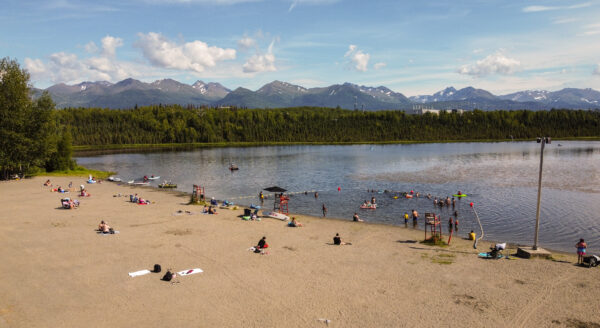
Anchorage just had its second warmest June on record, and the month is also expected to go down as one of the driest Junes ever statewide — if not the driest.
That’s according to National Weather Service climate researcher Brian Brettschneider, back for our Ask a Climatologist segment. And he says, while the meager June precipitation totals aren’t official yet, a drought designation for parts of the state is.
Listen:
[Sign up for Alaska Public Media’s daily newsletter to get our top stories delivered to your inbox.]
The following transcript has been lightly edited for clarity.
Brian Brettschneider: There’s a large fraction of the state, from the central Interior, through Southcentral and through Southwest, classified as being in a drought. There’s up to five levels of drought, so a sizable area is in Level 1 drought, what we call D-1 drought. And then areas here in Southcentral, right around Anchorage from, say, maybe Talkeetna down to the Kenai Peninsula, Ninilchik, is in Level 2 drought, which encompasses, you know, probably more than half of the population of Alaska. That’s probably going to be expanding when we update that next week. So don’t be surprised if that Level 2 drought area looks quite a bit bigger next week.
Casey Grove: That’s kind of when the official numbers come in?
BB: So the weekly Drought Monitor is updated every Thursday. And so for people that mark those things in their calendars, Thursday’s when to keep an eye out for that.
CG: OK, I’m gonna put that in my calendar. This is probably a slightly dumb question, but what does it mean to be in drought? What is the threshold you have to cross or, I guess, what lack of rainfall do you have to have?
BB: That’s a really interesting and surprisingly complicated question. So there is no formal criteria for drought in Alaska or anywhere. By definition, it’s a lack of precipitation that has negative impacts to people, agriculture, hydrology, the water supply. But it’s just kind of left at that. And so there’s a lot of subjectivity in how we describe areas being in drought or not drought. And really, it’s only been in about the last 10 or 12 years that people have even asked the question, “Can you have a drought in Alaska? Sure, you can be dry, but is it a drought?” And we’ve kind of come to the the realization that, yeah, absolutely, you can have a drought. But then also, you know, a drought in Southeast is different than a drought in the Interior, which can be different than a drought in Southcentral. So Ketchikan had a big drought, Metlakatla, a few years ago, even as they’re getting 100 inches of rain a year, because their reservoirs were so low, they weren’t able to generate hydroelectric power. That’s a very different kind of situation than you would have in the Interior, where you might not get any rain for much of June or July, everything dries out, and it becomes very flammable. But at the same time, it could be you could have fires running through a swamp, because of permafrost and standing water. So it’s really a complicated question, probably more than you were bargaining for.
CG: That has prompted me to take a drink of this glass of water. It’s so dry!
BB: It’s a dry drought.
CG: It’s a dry drought. It feels very dry. Speaking of how the conditions feel to us, I saw you quoted in a story about how it might feel hotter in northern latitudes at the same temperature than maybe somewhere farther to the south. How is that possible? What do you mean by that?
BB: Well, there’s a couple of ways to think about it. And one is, you know, if you’re outside, in Oklahoma, and it’s 75 degrees, and the sun is almost straight overhead, the sun really isn’t hitting a lot of your body. And even much of this, you know, the sides of your body that it is hitting is a very, very acute angle. And so it really kind of reflects off. And so it’s a relatively small fraction of your body that’s getting that direct sunlight, whereas here, our sun angle is much lower. And so when it’s 75 degrees in June or July, that direct sunlight is hitting you almost at a right angle, most of your body. And so you’re actually accumulating a lot more solar energy at that same temperature here in Alaska than you would at a southerly latitude.
CG: Interesting. So it’s kind of like the the wind chill version of the heat in the summertime.
BB: Sure, you can think about like that.
CG: I feel like people down in the Lower 48 that are not wearing a hat, maybe they have a bald spot, they’re at a greater risk, right? If the sun’s just straight down?
BB: Yeah, you know, that’s why we have hats. Wear the hats out if it’s hot and sunny.
CG: OK, so the natural transition here to fire danger is… firemen wear special hats? I don’t know. But we need to talk about that, for sure. We’re at kind of the middle of summer here-ish. The heat and the dryness just continues. So where are we at with that? How dangerous are things for fires?
BB: Well, statewide, we are at just about 2 million acres burned and through the end of June (2.4 million, as of July 5). That’s a record. That’s the most we’ve ever had burned through this point of the year. Now, the final season records are in the 5 to 6 million acre range. And hopefully we don’t approach those values, but it has been very, very dry. And there are many record fires in the southwestern part of the state. … So we’re really piling up the fire acreage statistics, and it’s really quite dramatic what’s going on. And most people have noticed the smoke here in Anchorage. We have a slight reprieve from the smoke, but other areas it’s apocalyptic. Nome had perhaps their smokiest conditions in at least 40 years. You know, close your doors and seal your windows kind of level. And we’re really moving toward an upper echelon fire year in Alaska. There’s just no silver lining.
Casey Grove is host of Alaska News Nightly, a general assignment reporter and an editor at Alaska Public Media. Reach him at cgrove@alaskapublic.org. Read more about Casey here.





